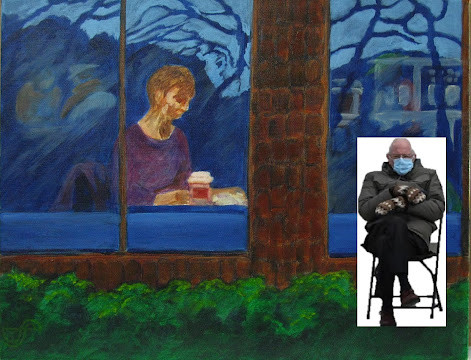A frosty mid-January at VanDusen Garden, and there's Dr. Menzies, my favourite of the celebrated botanists, looking out on the dormant rose garden. No doubt he's dreaming of that August afternoon when, to indulge some visiting art students, he agreed to hold his pose.
Right now: Could the rain please stop? And could the days please get longer SOONER? Well, what choice do we have but to put up with it and maybe try to remember there are charms, if sometimes eerie, to what the French call "l'heure entre chien et loup" – "the hour between dog and wolf." Dusk. Twilight. When it's hard to distinguish what's there and what's not.
It was about this time last year when I'd started an all-day Monday art workshop on Granville Island. Just reaching the bus stop at the end of the day, I was astonished at this woman's pose in the window of a darkening Starbucks. The bus was rolling up and with my little-used phone camera, I quickly grabbed this shot:
The scene came back to me early this year as I began to extend the Zodiac Café series with still lifes, surroundings and interiors. Of course, the Zodiac Café is a much cozier place than Starbucks, any of time of day, and it exists in a parallel universe where people socially distance only by choice. I did a quick study, giving it some cedar siding, and an off-the-beaten track setting among shrubbery and trees.
I also made some early choices about the windows, not as regimented as the faux-industrial looking ones at the entry to Granville Island. Of course, the woman's figure was the focus, and I did a quick study of the face, thinking that it might present a challenge.
Then I did a more complete study, ¾ -size with markings I'd be using to scale it up. Oh, dear – what was I thinking, with all these straight horizontals and verticals? Well, there was nothing for it but to press onward.
In the quick layout on the full-size canvas, I quite liked the couple in the background. Sometimes these early stages and even the studies are better than the final outcome (spoiler alert!).
And now I was under way…
…and becoming more and more uncertain as I tried to recapture the impact of the original photographed scene.
This was not what had struck me at the bus stop – nor was I trying to duplicate the scene. But the reflections were confusing, and the actual lighting was paradoxical. That is, it seemed that the inside of the coffee shop was darker than the outside – and with exceptions, it wasn't clear at all what was being reflected. So….? What the heck. I decided to plug in some of the light reflections of the background buildings and call it a day. Here, for better or worse, is "Winter Evening at the Zodiac Café," (copyright 2021)
I signed off on my notes and records and went upstairs, still thinking about the paradoxical reflections. This brought to mind other nighttime scenes that have enticed artists – successfully!
There's VanGogh's familiar "Café Terrace at Night". Check towards the bottom of this link, and you'll see a photo of his café as it still exists.
And of course, there's the magnetic "Nighthawks" by 20th century American artist Edward Hopper. I gleaned through my art books to check some good reproductions, half wondering if there were any reflections to offer guidance.
Then I went to my computer and the morning's email brought one of my art newsletters. There, by remarkable coincidence, was 2021's version of fame:-- Bernie Sanders among the Nighthawks!!
Should I go back and plug him into "Winter Evening"? Oh, I couldn't resist – but this took me an hour to figure out – and meanwhile, somewhere in the depths of my new computer sits an image of Bernie in solitary splendour, with just his chair and his mittens, unencumbered by the white border.























